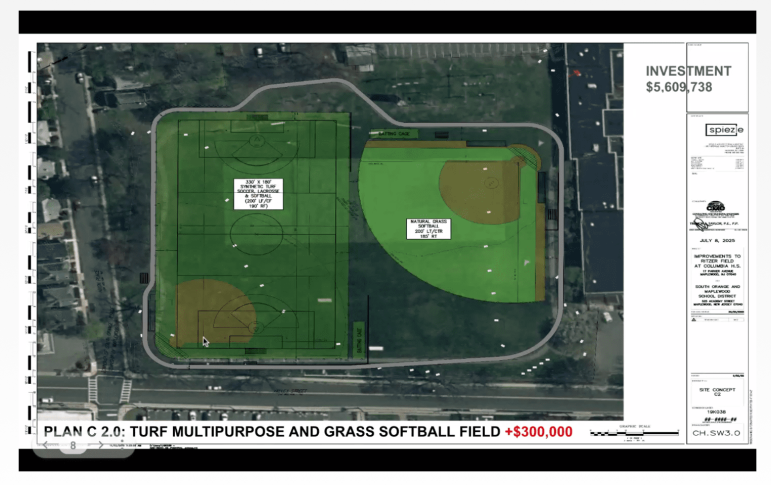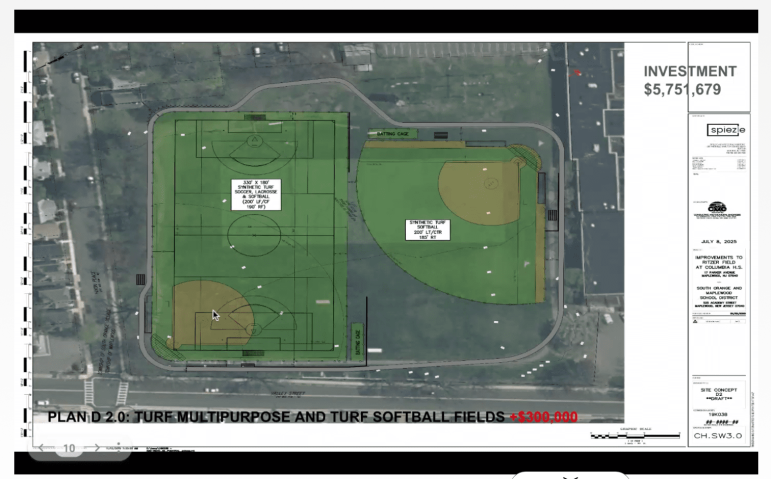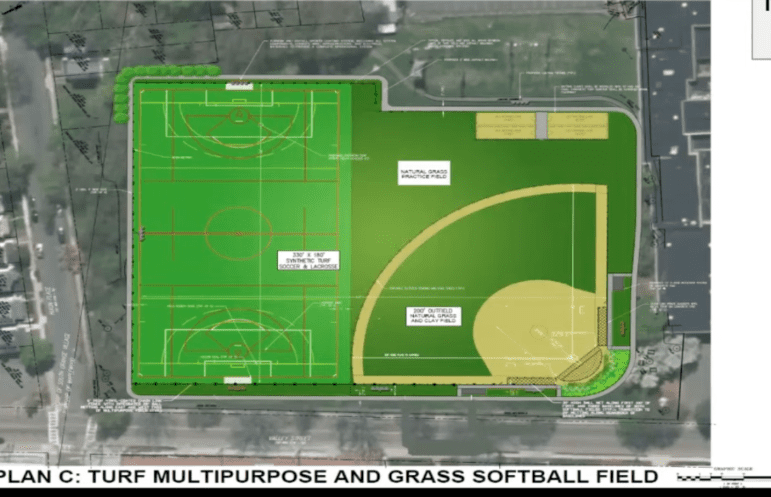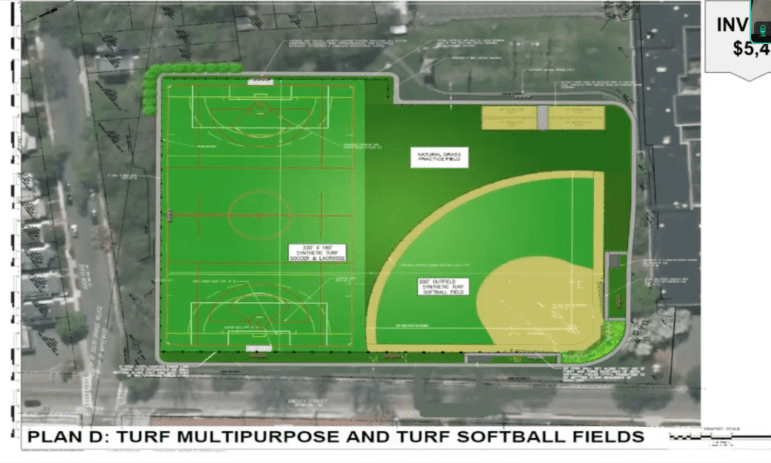With the South Orange-Maplewood Board of Education set to vote on a plan for upgrades to Ritzer Field on July 24 (and the Board of School Estimate expected to vote on funding sometime in late August), Schools Superintendent Json Bing held a virtual town on July 9 to answer questions on the various options — and on the hot button topic of artificial turf.
Bing noted that the district was asking the Board of School Estimate to approve spending in excess of $10M — which also includes several million for secondary school auditorium improvements.
“No matter what plan, the district will be in the area of around $10 million for our ask for the Board of School Estimate,” said Bing. “In regards to what that looks like for a $800,000 to $850,000 home, you’re looking at in Maplewood, around an increase of $56 [in annual local taxes] and in South Orange around an increase of $63. ”
Bing sought to answer questions about stormwater drainage, Title IX/equity for girls sports, field usage coordination with the townships, lighting, parking, tree planting, Project Adventure, funding, and more. Scroll down for the Q&A. Village Green has sent a followup question about blade treatment with PFAS (forever chemicals) and microplastic runoff, as well as a request for clarification on legal actions against the district, and will update the article when responses are received.
Bing did answer a submitted question (not included in the Q&A) referencing health, stating: “So, obviously, part of this work has been reviewing many, many studies. I’ve been part of various field upgrades over the past 20 years, and have had the opportunity to review many studies. More recently, one of the larger studies was from the Environmental Protection Agency, working with other agencies, doing a research report, really reaffirming the safety of synthetic turf fields. That was done in April 25, 2024. Again, that was the EPA and various other agencies, not only national, but international as well, reaffirming the safety of synthetic turf fields.”
Bing also introduced modified versions of Plans C & D that added a second girls softball field:


“We’ve asked our architect to make some revisions on our Plan C and our Plan D,” said Bing.
“Plan C 2.0 … is a turf multipurpose field. Again, lacrosse, soccer turf field with an inset girls turf softball field, as you can see in the diagram. And then also a grass softball field. You’re looking at an investment of about $5.6M for Plan C 2.0.”
“We also updated Plan D,” said Bing, introducing “Plan D 2.0, which is a turf multipurpose field. Again, soccer, lacrosse with an inset girls softball field, in addition to another girl softball field. … This investment totals out to around $5.7 million. So if you attended our Board of School meeting about a month ago, you’ll note that all the plans have stayed the same except we upgraded Plan C to a Plan C 2.0, which added an inset girls softball field. And then we also updated our Plan D from its original format to a Plan D 2.0, with again, inset a girls softball field.”
See the former Plans C & D here:

Former Plan C. June 16, 2025.

Numerous local residents have spoken against the use of artificial turf in the Ritzer Field plans (all of the plans include artificial turf, but in varying degrees) at several recent meetings. Read more here:
Commenters Ask Board of Ed to Abandon Artificial Turf Plans for Ritzer Field
Hixon Place Residents Oppose Turf on Ritzer Field, Ask Towns for Help
Other community members have shared emails to the BOE and BOSE in support of turfing Ritzer, and Village Green interviewed two CHS coaches on the topic here:
Coaches, Administrators, Proponents Say Turf on Ritzer Ensures ‘Everybody Has Access’ to Sports
Four plans for Ritzer were unveiled at a June 16 Board of School Estate on June 16, with the majority of township officials expressing support for Plan/Option D here:
School & Town Leaders to Discuss Plan & Funding for Ritzer Field Improvements June 16
The school district is providing information on the plans on its website here: https://www.somsdk12.org/district/business/ritzer
A recording of the July 9 webinar, which was not available at the time of publication, will be posted here: https://www.somsdk12.org/calendar/webinars
FROM SOMSD on July 9, 2025:
Ritzer Field/Auditorium Projects Q&A
The South Orange & Maplewood School District and Board of Education are requesting a new school district bond project to the Board of School Estimate that will be voted on by the Board of Education on July 24th, 2025 at its monthly meeting.
The purpose of this town hall is to answer any questions from the community regarding the process and tax funds required for upgrades to Ritzer Field and our school auditoriums. Redevelopment of Ritzer Field with the addition of a turf athletic field was originally part of the 2019 LRFP, however COVID inflation created a budget shortage; therefore we need to raise additional funds to meet the outstanding obligation to taxpayers and complete the work. In addition to the original Ritzer work, we also have an obligation to provide long overdue accessible fields for our female athletes. To ensure construction can begin by the summer of 2026 (to avoid student disruption) funds are being requested now. Final action by the Board of School Estimate will likely occur in August. Proposed plans will be made available on the SOMSD website.
*Please note: In 2019, Ritzer Plan A was approved (turf soccer/lacrosse field).
The bond would fund the following:
|
(1) Where can we review initial proposals? Please visit the SOMSD website to see the four proposed plans for Ritzer and the Secondary Schools’ auditorium proposal. Please visit the district website.
(2) What is the expected process moving forward?
- July 9th, 2025 SOMSD Town Hall answering questions about Ritzer and Auditorium Plans (virtual).
- July 24, 2025 Board monthly meeting (action will be taken). Board to vote on final Ritzer Field/Auditorium funding request. Resolution is then sent to BOSE for a meeting no earlier than 15 days and no later than 30 days from the request.
- August (TBD): BOSE Public Meeting (action will be taken) Vote on final funding request.
(3) Equity for Girls Softball – What are the plans to create equity for our girls softball teams so they have two fields to play on as do the boys baseball teams? The district is reviewing development plans for Ritzer Field that would include two softball fields, to accommodate simultaneous varsity and junior varsity games, for instance, in addition to options for scheduling to accommodate both teams. Currently, Plan C 2.0 and D 2.0 allows for two softball games to be played simultaneously.The focus remains on our students and playability of the fields.
(4) The district, as with many other districts in NJ, is in very tight fiscal times. Does taking on more debt make sense? School bonds are used to finance major capital projects that would be impossible to build using only annual school district revenue. This includes:
- Building new schools
- Major renovations or expansions of existing buildings
- Significant infrastructure upgrades (e.g., HVAC, roofs, technology)
- Purchasing land for new facilities
- Large equipment purchases (like school buses in some cases)
Bonds are a form of borrowing. The school district issues bonds, which are essentially promises to repay investors with interest over a long period (typically 10-30 years). The repayment of these bonds comes from a dedicated increase in local property taxes. It is important to note that Bonds are for long-term investments in physical infrastructure while District Operating budgets are for short-term, recurring expenses that keep the schools running day-to-day.
Many of our district’s facilities are outdated or in a state of disrepair because of the failure over many years to adequately invest in our school infrastructure. We believe a measured and thoughtful approach to improvements in our physical plant through bond projects like these, in addition to other infrastructure opportunities such as the Energy Savings Improvement Project, are important to ensure our facilities keep pace with the needs of our students.
(5) What stormwater retention infrastructure is in the plan? The site has been reviewed by our architects and engineers and we have given them a mandate to create stormwater drainage that meets or exceeds requirements. As per their recommendations, the runoff would be stored in the broken stone base layer beneath the field. This layer may end up being a couple of feet deep across all or a portion of the field. The calculations would need to be confirmed once the grading plan is finalized and test pits are conducted to verify groundwater depth. Unlike the 2019 Ritzer plan, the district will utilize underground pipes for a more efficient design to limit excavation.This will more than quadruple the amount of water that can be efficiently stored.The proposals will have the turf integrating with an underground water detention system, in compliance with current state and local law.
- Turf Layer: The artificial turf itself, with its perforated backing, allows rainwater to drain through.
- Infill Layer: The infill (rubber crumb, sand, and/or organic material) also allows water to percolate. This is the district preference.
- Drainage Base: Beneath the turf and infill is a highly permeable aggregate base (typically crushed stone, gravel, or specialized drainage cells). This base is crucial as it acts as a primary filter and conveyance layer.
- Underground Chambers: Instead of allowing the treated water to simply infiltrate into the soil (which might not be feasible in all soil types or for large volumes) or directly discharge into the stormwater system, the water is directed into a stormwater detention system. The detention system is typically made of high-strength plastic (like PP modules/prefabricated sections of polypropylene pipes) or concrete and are designed to hold significant volumes of water (4 x as more than just stone and gravel).
- Slowly released (detention): Discharged at a controlled, reduced rate into the municipal stormwater system, preventing overwhelming infrastructure during peak rainfall. This helps mitigate downstream flooding and erosion. The configuration of the new fields also takes advantage of the natural slope of Ritzer.
- The field will need to accommodate a drainage design for up to the latest 100 year projected rainfall rates published by DEP. All of this will be confirmed during design development. Additionally, due to climate change, the DEP now requires 30% above and beyond the 2019 requirements.
(6) Is there proposed lighting? If so, what methods will be utilized to ensure quality of life for neighbors? There will be a lighting option in all proposed Ritzer Field plans. A photometric analysis will be conducted if a lighting project is initiated. There are various options to reduce exposure to lighting, including shields, angle of lights, minimizing the height of poles, light heads with different expressions, and timed systems.
(7) What is the proposed tree planting? Would the SOMSD / BOE, as a public land steward of many large areas of open space in our community, commit to joining Maplewood and South Orange in a program of robust tree planting? The plan incorporates the planting of trees along Hixon Place as natural fencing. In its current state, the plan will not remove any healthy mature trees along Valley or Hixon. The district and architect will be utilizing arborists to determine mature tree health. Additionally, if any mature tree needs to be removed, two new trees will be planted. The district will be working with both towns around tree planting.
(8) Artificial turf retains more heat than natural grass. How does the district plan to mediate this effect?
- Alternative/Organic Infills (e.g., Cork, Walnut Shells, Coconut Coir): These natural materials tend to absorb less heat and have better thermal properties than traditional crumb rubber infill. Some can also retain moisture for evaporative cooling.
- Reflective or “Cooling” Fibers: Some manufacturers are developing turf fibers that incorporate special pigments or coatings designed to reflect more sunlight rather than absorbing it. These fibers aim to reduce the initial heat absorption of the turf blades.
- Blade Shape and Density: Some turf designs use specific blade shapes (e.g., W-shaped) or lower pile densities to allow for better airflow and heat dissipation, reducing overall heat buildup.
(9) What about parking and traffic? The district owns multiple parking areas around Ritzer Field including directly across the street, next to gymnasium, Parker Avenue lots (2) and the central office lot. Signage will be installed directing visitors to appropriate parking areas. Finally, Maplewood and SOMSD will be working together to develop a lighted walkway across Prospect St from the parking lot to the field.
This is a joint venture between SOMSD/municipalities, therefore Ritzer Field, as it is now, will be open to the public and also available to rent (similar to Underhill).
(10) What will happen with Project Adventure equipment? PA will remain in place. The only revision needed will be the zipline-that will be moved approximately 100 feet towards Academy St. reducing the length of the line by an estimated 30 feet.
(11) If two girls softball fields (turf) and a lacrosse/soccer field (turf) are part of the Ritzer Plan, will any grass area remain? Plan D 2.0 will keep over 22,000 sq feet of natural grass inside the perimeter of the walking path, with a new irrigation system upgrade.
(12) Will there still be areas for students to congregate? Yes, a natural grass area is featured in three of the four proposed plans (@2200 sq. feet). While Ritzer intended use is as an athletic field, students will continue to be able to have lunch/recess on Ritzer Field. An upgraded walking path will be installed around the perimeter of the fields for physical education classes as well.
(13) Does Ritzer Field have protected wetlands that would restrict development? The district commissioned a study from the NJ DEP to confirm whether there were any designated wetlands within the Ritzer Field area. The DEP testing results were given to the district in March- “..the Division has determined that freshwater wetlands and waters are not present.”
(14) Has the district worked with both municipalities in regards to playing fields? Yes-the district and municipalities have had ongoing conversations about the lack of playing fields in SOMA/SOMSD. Even with the development of Ritzer, there is still a need for more fields. At Columbia High School alone, about 50% of students participate in a sport. Furthermore, we are adding middle school athletics in 2025-26. Currently, the Underhill Complex is utilized all of the time. Often games are scheduled in tiers throughout the day.
(15) Is it true the district has or had pending litigation against it for Title IX violation? Yes. There are Title IX and LAD claims challenging the inferior facilities afforded to female athletes. It is essential that the district add playing facilities, including a softball field, to address this issue.
(16) Is there really a need for a redeveloped field at Ritzer? There were many cancellations this spring resulting in a decrease of spring season games played. Usually we play 19-20 games, 9-10 of which are at home. Due to weather conditions, only 5 home games were played this season. Playability and demand is consistently a challenge. Furthermore, our student athletes have also been vociferous around the redevelopment of Ritzer Field-specifically the addition of turf. The redevelopment will also provide an opportunity to synergize the community around fundraising for items such as scoreboards, snack shacks, bleachers and more.
(17) What is Plan E? The district has not proposed a “Plan E,” but this name has been adopted by advocates for a fully natural grass option. We are sympathetic to the views of those who would like to see Ritzer kept in its current state or redeveloped without the use of synthetic turf. Our decision to not pursue a natural grass field option is rooted in its decreased playability time and increased ongoing maintenance needs and costs as compared with turf. Maintaining a natural grass athletic field would require significant equipment purchases and upkeep, hiring additional trained personnel to tend to the playing surface, and funding those annual upkeep costs within our operating budget year over year. To be clear, the district is sensitive to environmental concerns and to being a good neighbor with its resources, including its property. At the same time, we have an obligation to operate adequate facilities for our district operations, including our athletics program, and this project is needed to meet that goal.
(18) Is Ritzer currently in the operational school budget? Ritzer is maintained by our facilities team in its current state, but there is no money within the budget specifically for redevelopment of the field. While funds were allocated to Ritzer development in our 2019 bond, the increased cost of our capital plan post-Covid resulted in some projects not being completed due to a lack of funds, and Ritzer was one of those projects.
(19) How will maintenance of Ritzer be handled?
Initial installation costs: Initial install costs for turf are higher. The estimates below include a nominal 24-year cycle which includes a turf surface replacement within the cycle. Grass will require annual re-seeding and some re-sodding over this time period which is estimated.
Maintenance costs: Maintenance costs are higher for grass but will depend on many factors including use, weather (hot/dry periods will demand higher irrigation and maintenance efforts for grass for example). The estimates include an estimated irrigation cost and assume purchase of basic equipment over the extended cycle.
Hours of use: Turf fields can be used far more heavily including in any weather conditions and can be used day of, or after rains. Grass fields would typically require at least a day to dry after rains and have a shorter season when they can be used. The estimated install and maintenance costs are also represented as cost/estimated hour of available use. CME (site engineers) provided an estimated number of annual use hours based on their experience which has been utilized. See SOMSD website.
(20) Does this project require a zoning review from the town? It does not. However, we will be working closely with municipalities around this initiative. Again, the challenge for the district and municipalities has been the lack of fields. Additionally, we will be creating a community action committee to increase transparency. We launched our initial action committee this budget cycle and found the model to be very effective.
[There is no Question 21.]
(22) What are the plans for the current full grown trees on Ritzer?
It is our goal to preserve as many of the existing trees surrounding Ritzer as possible, while creating field spaces that best meet our district and community needs and maintaining a meaningful grass component as well. Our current plans do not anticipate needing to remove any healthy mature trees. We are committed to planting at least two trees for each one that does need to be removed.
(23) Can you fix the Title IX problem by remaking your schedule to share field time equally between boys and girls sports? If not, it would be helpful to explain your thinking. This would give you more time to plan for additional playing field space at Ritzer or elsewhere. We are hopeful to find additional playing field space in the future, and district space generally, but we have an obligation to provide this equitable space now, and to create playing field spaces for our current students, not just future students. One option that has been used in the past was to convert fields from baseball to softball with moveable mounds, but this has created safety concerns and increased scheduling complexities.
(24) Is there a plan for responsible disposal of turf once it hits its life expectancy? The district intends to work with our turf vendor to identify to the greatest degree those components that could be recycled, and to ensure that all pieces are disposed of responsibly.
(25) The CHS auditorium has been under construction this year-what work is being done? The stage rigging is being replaced.
(26) We understand that ceiling tiles had fallen from the auditorium in MMS, will this be part of the proposal? Yes, a new ceiling, if deemed necessary by a contractor, will be installed. Additionally, monies have been allotted in the proposal for asbestos abatement if required.
(27) All of the a(uditoriums in SOMSD need to be repaired, refreshed and/or replaced, and we have numerous other capital project needs as well. Why does the proposal only focus on the secondary schools auditoriums? Our secondary school stages get the most use. They are in far worse condition than our elementary spaces. Elementary auditoriums and many other district infrastructure needs will be included in our five year “Long Range Facility Plan.”

